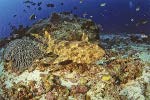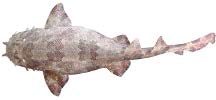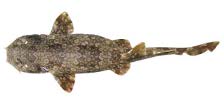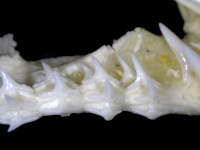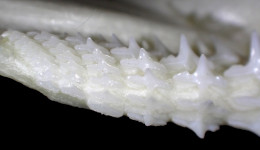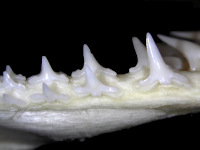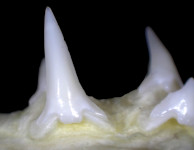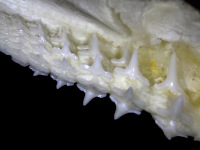Orectolobus leptolineatus
Last, White & Pogonoski, 2010
Indonesian wobbegong
Classification: Elasmobranchii Orectolobiformes Orectolobidae
Reference of the original description
A new wobbegong shark, Orectolobus leptolineatus sp. nov. (Orectolobiformes: Orectolobidae), from the Western Central Pacific. CSIRO Marine and Atmospheric Research Paper, 32, 1–16
A new wobbegong shark, Orectolobus leptolineatus sp. nov. (Orectolobiformes: Orectolobidae), from the Western Central Pacific. CSIRO Marine and Atmospheric Research Paper, 32, 1–16
Image of the original description
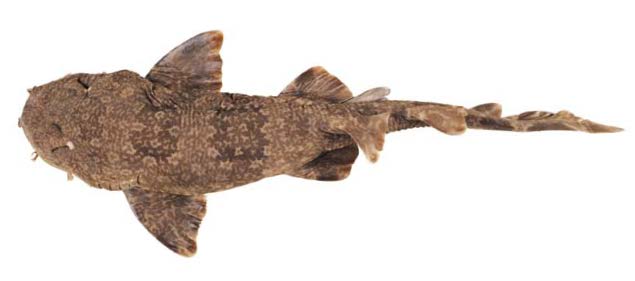
Orectolobus leptolineatus sp. nov, adult male holotype (MZB 18623, 887 mm TL, preserved): dorsal view; In: Last, P.R. & White, W.T. & Pogonoski, J.J. (2010): A new wobbegong shark, Orectolobus leptolineatus sp. nov. (Orectolobiformes: Orectolobidae), from the Western Central Pacific. CSIRO Marine and Atmospheric Research Paper, 32: 1-16

Orectolobus leptolineatus sp. nov, adult male holotype (MZB 18623, 887 mm TL, preserved): dorsal view; In: Last, P.R. & White, W.T. & Pogonoski, J.J. (2010): A new wobbegong shark, Orectolobus leptolineatus sp. nov. (Orectolobiformes: Orectolobidae), from the Western Central Pacific. CSIRO Marine and Atmospheric Research Paper, 32: 1-16
Synonyms / new combinations and misspellings
Orectolobus cf. leptolineatus
Orectolobus cf. leptolineatus
Types
Orectolobus leptolineatus
Holotype: MZB: 18623; Paratype: CSIRO: H 6138-02; CSIRO: H 6446-03; CSIRO: H 6128-06; CSIRO: H 5876-03; CSIRO: H 5787-01; CSIRO: H 5787-02; Indo-Oz: L154; MZB: 15471; MZB: 15100; MZB: 15435;
Orectolobus leptolineatus
Holotype: MZB: 18623; Paratype: CSIRO: H 6138-02; CSIRO: H 6446-03; CSIRO: H 6128-06; CSIRO: H 5876-03; CSIRO: H 5787-01; CSIRO: H 5787-02; Indo-Oz: L154; MZB: 15471; MZB: 15100; MZB: 15435;
Description :
Citation: Orectolobus leptolineatus Last, White & Pogonoski, 2010: In: Database of modern sharks, rays and chimaeras, www.shark-references.com, World Wide Web electronic publication, Version 12/2025
Please send your images of "Orectolobus leptolineatus" to info@shark-references.com

Orectolobus leptolineatus sp. nov, adult male holotype (MZB 18623, 887 mm TL, preserved): lateral view; In: Last, P.R. & White, W.T. & Pogonoski, J.J. (2010): A new wobbegong shark, Orectolobus leptolineatus sp. nov. (Orectolobiformes: Orectolobidae), from the Western Central Pacific. CSIRO Marine and Atmospheric Research Paper, 32: 1-16

Orectolobus leptolineatus sp. nov, adult male holotype (MZB 18623, 887 mm TL, preserved): lateral view; In: Last, P.R. & White, W.T. & Pogonoski, J.J. (2010): A new wobbegong shark, Orectolobus leptolineatus sp. nov. (Orectolobiformes: Orectolobidae), from the Western Central Pacific. CSIRO Marine and Atmospheric Research Paper, 32: 1-16
Common names
 Indonesian wobbegong
Indonesian wobbegong
 Indonesian wobbegong
Indonesian wobbegong
Short Description
This medium-sized (to at least 120 cm TL) Orectolobus species is distinguished by the following set of characters: coloration complex and variable, strongly vermiculate over dorsal and lateral surfaces with alternating dark brownish bars and saddles; dorsal and upper surface of paired fins with prominent vermicular patterns; ventral surface of trunk mainly uniformly pale; nasal barbel with a branch; preorbital dermal lobes complex, with 2-3 simple lobes in PO1 group and 3-4 simple to terminally branched lobes in PO2; simple postspiracular dermal lobes, well- developed, thallate, distance across preorbital group 1.3-1.6 times interspace between preorbital group and postspiracular lobe (PO/PO-PS1), 6.5-8.0 times base length of anterior postspiracular lobe (PO/PS1); base of anterior postspiracular lobe 4.3-5.3 in its distance from postorbital group (PO-PS1/PS1), 2.5-2.9 in its distance from posterior postspiracular lobe (PS1-PS2/PS1); enlarged supraocular knob or warty tubercles on back absent; dorsal fins tall, upright; first dorsal-fin origin near insertion of pelvic fin; tip of pelvic fin below insertion of first dorsal fin; interdorsal space 0.5-0.8 times anal-fin base length; anal-fin inner margin 0.7-0.8 of anal-fin posterior margin; 23 tooth rows in upper jaw, rudimentary row of teeth at symphysis of upper jaw usually present; monospondylous centra 44-51; total vertebral centra about 148-163 (Ref. 84278).
This medium-sized (to at least 120 cm TL) Orectolobus species is distinguished by the following set of characters: coloration complex and variable, strongly vermiculate over dorsal and lateral surfaces with alternating dark brownish bars and saddles; dorsal and upper surface of paired fins with prominent vermicular patterns; ventral surface of trunk mainly uniformly pale; nasal barbel with a branch; preorbital dermal lobes complex, with 2-3 simple lobes in PO1 group and 3-4 simple to terminally branched lobes in PO2; simple postspiracular dermal lobes, well- developed, thallate, distance across preorbital group 1.3-1.6 times interspace between preorbital group and postspiracular lobe (PO/PO-PS1), 6.5-8.0 times base length of anterior postspiracular lobe (PO/PS1); base of anterior postspiracular lobe 4.3-5.3 in its distance from postorbital group (PO-PS1/PS1), 2.5-2.9 in its distance from posterior postspiracular lobe (PS1-PS2/PS1); enlarged supraocular knob or warty tubercles on back absent; dorsal fins tall, upright; first dorsal-fin origin near insertion of pelvic fin; tip of pelvic fin below insertion of first dorsal fin; interdorsal space 0.5-0.8 times anal-fin base length; anal-fin inner margin 0.7-0.8 of anal-fin posterior margin; 23 tooth rows in upper jaw, rudimentary row of teeth at symphysis of upper jaw usually present; monospondylous centra 44-51; total vertebral centra about 148-163 (Ref. 84278).
Distribution
Western Pacific: Indonesia. Probably also from off Sarawak Malaysian Borneo and conspecific forms collected from off southeastern Sabah, the Philippines (Visayas and Cebu City), Taiwan (Penghu Islands), and the Okinawa region of Japan. Source: www.gbif.org
Western Pacific: Indonesia. Probably also from off Sarawak Malaysian Borneo and conspecific forms collected from off southeastern Sabah, the Philippines (Visayas and Cebu City), Taiwan (Penghu Islands), and the Okinawa region of Japan. Source: www.gbif.org
Biology
The depth range of this species is not well defined; specimens observed at fish markets were presumably caught by longline fishers operating in deeper parts of the continental shelf. It probably prefers deeper colder water with a single shallow water observation from the east coast of Bali where cold-water upwelling is common. All males (n = 43) mature by ca 90 cm TL; smallest mature female recorded at 94 cm TL, two pregnant females recorded at 104 and 108 cm TL, smaller of the two pregnant females contained 4 mid-term embryos between 13 and 14 cm TL (Ref. 84278). Tropical
The depth range of this species is not well defined; specimens observed at fish markets were presumably caught by longline fishers operating in deeper parts of the continental shelf. It probably prefers deeper colder water with a single shallow water observation from the east coast of Bali where cold-water upwelling is common. All males (n = 43) mature by ca 90 cm TL; smallest mature female recorded at 94 cm TL, two pregnant females recorded at 104 and 108 cm TL, smaller of the two pregnant females contained 4 mid-term embryos between 13 and 14 cm TL (Ref. 84278). Tropical
Habitat
Benthopelagic; marine
Benthopelagic; marine
Remarks
shark-references Species-ID=9006;
shark-references Species-ID=9006;








